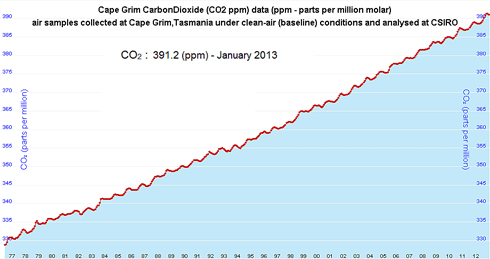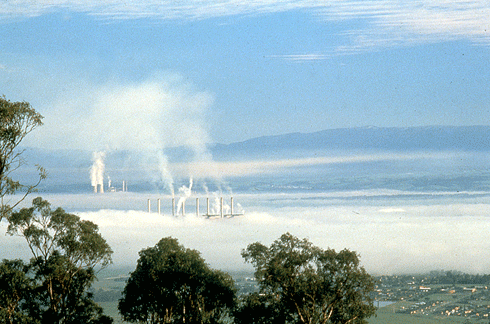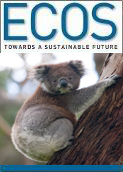
|
Published: 29 April 2013
More evidence for human fingerprint on climate change
Three new published studies, each looking at a different aspect of humankind’s impact on climate, all carry the same sobering message. The first study concludes that recent warming is unprecedented in 2000 years. A second reports climate zones are shifting faster due to warming temperatures. The third argues impacts from greenhouse gas emissions are not caused solely by warming temperatures.
The one that will likely attract the most attention is a reconstruction of global temperature over the last 2000 years. This was a mammoth collaboration, involving 78 scientists from 60 scientific institutions, all part of the PAGES network (Past Global Changes). This network enabled researchers to use ice cores, tree-rings, lake sediments and other forms of data from all over the globe. The result – the PAGES 2k Paper – is a robust reconstruction of temperature across seven continents over 2000 years.
The scientists found that over the last 2000 years, the planet had been gradually cooling. This cooling trend reversed around the time that humans started emitting heat-trapping gases into the atmosphere. Since then, global temperatures have been rising, with the last few decades the warmest in 1400 years.
If this sounds familiar, it’s because this research is the latest in a long line of papers published over the past 14 years that have consistently found recent warming is unprecedented over the past 1000 or so years. The seminal paper on global temperature reconstruction was published in 1999 and has attracted much criticism from those averse to the notion of human intervention on climate. However, since that seminal research, a string of papers using different datasets and statistical methods have confirmed the results.
The PAGES 2K paper also found that while the planet as a whole has been experiencing unprecedented temperatures in recent decades, some pre-industrial regions were warmer than they are now. For example, Europe was possibly warmer during the Roman Warm Period. However, different regions warmed at different times. The modern period is the only time during which all regions have warmed simultaneously.
A second recent paper published in Nature Climate Change examined the shifting of climate zones due to warming temperatures. The paper’s authors found that due to warming, climate zones are moving at an increasing pace. If humans continue to emit greenhouse gases at the current rate, the speed with which climate zones shift will double by the end of the century. This means about 20 per cent of all land area will undergo a change.
Shifting climate zones are already causing thousands of animal species to shift towards the poles or higher altitudes in order to remain within a tolerable temperature range. The shift will also affect agriculture as precipitation patterns will change with the shifting climate zones.

|
|
Annual atmospheric CO2 measurements from 1977 to the present taken at Cape Grim on Tasmania’s west coast. Cape Grim is one of three accredited Baseline Air Pollution Stations in the World Meteorological Organization-Global Atmosphere Watch (WMO-GAW) network. The graph shows CO2 levels at Cape Grim currently approaching 400 ppm. A 450 ppm target was agreed upon in 2007 by scientists participating in the Intergovernmental Panel on Climate Change as the upper limit to avoid dangerous climate change. If atmospheric CO2 levels exceed this target, the IPCC said, global temperature will rise more than 2oC above pre-industrial levels. |
One suggested magic bullet to minimise the impacts of human-caused global warming is geoengineering – for example, putting tiny sulphate particles into the atmosphere could reflect incoming sunlight.
However, a third recent study published in Nature Geoscience found some impacts from greenhouse gas emissions cannot be fully mitigated by geoengineering. A simulation of business-as-usual greenhouse gas emissions over the 21st century found that many changes in regional rainfall weren’t related to surface warming. Instead, extra carbon dioxide in the atmosphere was causing shifts in atmospheric vertical motions, which led to changes in tropical rainfall. This means that even if geoengineering managed to cancel out surface warming, rainfall patterns would still change because of the extra carbon dioxide building up in the atmosphere.
There are other consequences of increased levels of carbon dioxide in the atmosphere, beyond surface warming. For example, the oceans are absorbing around half of our carbon emissions, which is having a negative impact on coral reefs due to ocean acidification.
Research into the impacts of human-caused global warming continues to mount. A Web of Science search for papers matching the terms ‘global climate change’ or ‘global warming’ finds an accelerating amount of climate research.
The increasing body of evidence only serves to strengthen the scientific consensus that was established in the early 1990s. Why then, is the general public still confused about climate change, lagging behind the scientific community by two decades?
Despite the steady accumulation of studies documenting the human impact on climate change, misinformation disseminated by a small number of climate misinformers has had an impact on how the public think about climate change. In my own research, I measured the public perception of scientific consensus by asking a representative US sample how many scientists agree that humans are causing global warming. The average answer was a shade under 50 per cent. This is in stark contrast to two recent studies that independently found a 97 per cent consensus.
This ‘consensus gap’ has policy implications. When the general public correctly perceive the scientific consensus, they are more likely to support policies to mitigate greenhouse gas emissions.
As more research like today’s slew of new papers are published, we can expect climate misinformers to continue to deny the full body of evidence. Inconvenient studies will be attacked and data will be cherry picked. The public need to understand that on a fundamental topic such as human-caused global warming, the attacks don’t come from genuine scientific debate but an attempt to generate false controversy.
The scientific consensus on human-caused global warming was established 20 years ago. It has only strengthened as the evidence continues to accumulate.
John Cook is Climate Communication Fellow at the Global Change Institute, University of Queensland. He also runs skepticalscience.com, a website that makes climate science accessible to the general public and examines the arguments of global warming skeptics. John also co-authored the book Climate Change Denial: Heads in the Sand and The Debunking Handbook, and is an Adjunct Lecturer at the University of Western Australia. This article was originally published at The Conversation.





